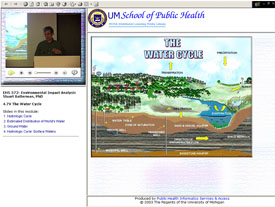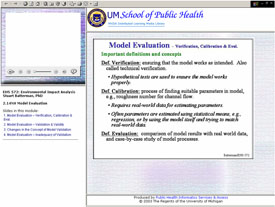| March 2006 Index | Home Page |
Editor’s Note: This research explores the relationship between esthetics, information elements and learning style preferences on learning and learner satisfaction. It reinforces existing research and praxis and provides new data for instructional designers and teachers to consider in the development of interactive multimedia and web-based learning.
Web-based Distance Learning Technology:
Effects of instructor video on information recall and aesthetic ratings
Cristina Pomales-García and Yili Liu
Abstract
This research examines the impact of several aesthetic/appearance characteristics of web-based distance learning environments on information recall and perceived content difficulty. Six web-based instructional modules were used, which consisted of fragments of different lectures, each containing a different topic and ranging between three to six minutes in length. The results show that appearance/aesthetic judgments do matter and they offer additional insights into the effectiveness of instructional methods beyond traditional performance measures. The integration of aesthetic/appearance judgments in the evaluation of web-based distance learning technology gives us valuable insights to deepen our understanding of what characteristics of the educational technology make it more appealing and successful.
Keywords: distance education, web-based distance learning, distance learning technology, aesthetics, information recall, multimedia learning, cognition and affect, web modules.
Introduction
In recent years, there has been an increasing interest in research on distance learning technology and distance education environments. Not only in the educational environment, but also in the literature distance learning has been explored. Bork (2000) looked at fictional accounts of the future of learning. He summarized the ideas from four novels written between 1950 and 1995 which projected the future of education as an environment where there are no schools the way we know them today. These stories also mentioned it was not necessary to have people gather at a central location for learning. In a way, these four novels are fictional predictions of the concept of distance learning, which is an option available in today’s educational world. In the year 2000 almost 90 percent of all universities with more than 10,000 students offered some form of distance learning, nearly all of which used the internet (Svetcov, 2000).
Distance education is based on two general concepts: (1) it is a model of instruction; where (2) the learner and learning resources are separated by space and/or time. Keegan (1988, 1996:50) developed a comprehensive definition of distance education as a form of education characterized by:
the quasi-permanent separation of teacher an learner throughout the length of the learning process;
the influence of an educational organization both in the planning and preparation of learning materials and in the provision of student support services;
the use of technical media (e.g., print, audio, video or computer) to unite teacher and learner and carry the content of the course;
the provision of two-way communication so that the student may benefit from or even initiate dialogue; and
the quasi-permanent absence of the learning group through the length of the learning process so that people are usually taught as individuals rather than in groups, with the possibility of occasional meetings, either face-to-face or by electronic means, for both didactic and socialization purposes.
Research in distance learning and education has been studied from two principal perspectives: technology-centered approach and learner-centered approach. The technology-centered approach is based on the functional capabilities of technology and asks questions from the standpoint of how those capabilities could be used for design purposes. The learner-centered approach takes into account the human mental capabilities and asks questions from the standpoint of how to create or adapt technologies to enhance learning (Mayer, 2001). The learner-centered approach is widely used because of a deeper understanding of the differences between the power of technology and the needs of the users, and a general recognition of users being the guiding force in the design. In today’s higher education community, many colleges and universities are creating distance learning courses to keep up with the needs of the student population and with institutional goals of making education accessible to more people all over the world. Our research focuses on the learner-centered approach to understand not only what in specific within the distance learning environment modules is accounting for the learning outcomes but it also takes into account the user perspectives as the guiding force.
With respect to the design of educational technologies and education systems, there are many human factors and ergonomics challenges. When evaluating web-based distance learning (WBDL) environments, which are being used more frequently by students to review and supplement class materials, human factors issues should be taken into account. These issues have traditionally included ease of use, workload or information processing demand, and potential physiological effects of the interaction on the users. The evaluation of the appearance/ aesthetic domain is not usually incorporated (Liu 2003a, 2003b). For example, in terms of the design criteria for web-based instructions, Miller and Miller (2000) suggest several theoretical and practical considerations, but aesthetic factors were not taken into account as important variables in the design of web-based instruction. Studies in distance learning education and technology measure overall performance and satisfaction with the course but do not identify which design characteristics within the individual courses are specifically accounting for the differences. Questions are not asked from the standpoint of what are the specific delivery method or WBDL design variables that influence student satisfaction ratings and how to measure these variables. Few studies consider the appearance/aesthetic perceptual component as an important variable in education technology. In this article, we describe our human factors/learner-centered research on WBDL technologies, investigating both performance and aesthetic factors. The technology we evaluated is web-based instructional modules, which are defined as self-instructional units for independent study (Heinich, Molenda, & Russell, 1982, pp. 281).
Literature Review
Distance Learning and Distance Education Research Approaches
In the distance learning research environment the most common research approach is to compare student performance between different teaching modes alternatives and measure student satisfaction. This is done by comparing student satisfaction and performance between traditional classrooms and distance education environments. In an early study on the influence of participants’ perception of aestheticism, evaluation, privacy, potency, and activity of a teleconferencing medium, Ryan (1976) found that both videoconferencing and face-to-face communication modes were perceived as more aesthetically positive than audio conferencing. However, both video and audio conferencing were perceived as more “potent” communication channels than face-to-face communication. The video and audio communication modes in Ryan’s (1976) study evoked in the participants a greater sense of social distance and formality (very common reactions to communication technology), even though they represented a somewhat narrower signal (stimulus) bandwidth than face-to-face communication. This study was able to determine and measure aesthetic characteristics or preferences of a sample to a communications medium but did not look at the influences between communication mode and its impacts on learning.
Allen, et al. (2002), conducted a meta-analysis study on research articles related to “distance learning,” “distance education”, and “satisfaction” with a distance education course and a course using traditional face-to-face methods of instruction. For the meta-analysis, a hierarchy of three types of distance learning or distance education formats was considered (media channels): writing, audio, and video. The concept of hierarchy states that audio education would include written information provided to and from the student, and that video education will, in addition, use audio and written materials. In this hierarchical scheme, it is assumed that the more complex media channel also utilizes the lower channels along with the more complex source of information. The assumption behind this idea is that students will demonstrate higher levels of satisfaction with channels that contain more information. This is called by Mayer (2001) the learning-preferences hypothesis, according to which different people learn in different ways, so it is best to present information in many different formats. For example, if face-to-face/traditional instruction is rated highest in satisfaction, then as each channel is removed, the expectation would be that the level of satisfaction would decrease with the alternative technology, indicating that it is the amount of information that is connected to the level of satisfaction. Would this hypothesis apply to distance education technologies when using a computer as the instructional medium?
The results from the meta-analysis (Allen, et al. 2002) showed that students indicate a slightly higher level of satisfaction with live course (face-to-face) setting than distance education formats based on a sample of 25 studies. The effect size comparison for the video channel in a sample of 23 studies, indicated a very small correlation favoring distance education. But when the video channel analysis is conducted excluding two relevant outliers the analysis is changed to favor slightly the traditional education. The comparison of videotaped instruction to the written communication format indicated that as the information in the channel is reduced, students indicate a preference for video over the written instruction. This is consistent with the author’s hypothesis stating that the ability to get more information, including visualization of the instructor, is a preferred method of instruction over more restricted channels.
Overall, the authors in this meta-analysis study concluded that the objections to distance education should not be based on the issues related to student satisfaction since students find distance learning as satisfactory as traditional classroom learning formats. This meta-analysis focuses on the impact of instructional format on satisfaction but disregards the learning aspects and the impacts of aesthetic variables between the different modes of instructions. Why only focus on which format is best, if ultimately the interest relies not only on satisfaction and acceptance but on the learning impacts of the different technologies? It is entirely possible that the students, while equally satisfied with distance education, do not learn as much as they would learn with the methods involving traditional face-to-face communication in a traditional classroom. Satisfaction with the educational process provides only one possible source of evaluation and must be compared to other evaluations of the effectiveness and value of any pedagogical device or procedure.
A meta-analysis by Machtmes and Asher (2000) across 19 studies in adult and higher education found little difference in learner achievement, measured through test scores, between the traditional face-to-face communication and distance learning. Among all the instructional features analyzed in this meta-analysis only the type of interaction available during the broadcast, type of course and type of remote site, had an impact on student achievement, which was coded as test scores on pretest/posttest, midterm or final exam. These findings provide evidence that distance learning may offer as much academic improvement as traditional learning environments.
In a study by Rutz, et al. (2003) on student performance and acceptance of instructional technology, the authors compare traditional and technology-enhanced instruction with a course about Engineering Mechanics. The technology-enhanced instruction in this study was defined as an interactive video class, web-assisted class or a streaming media class.
In an interactive video class the students are in a remote classroom and could see and hear the instructor in real time, and the instructor could see and hear students from the remote site.
Web-assisted classes were structured so that the student reviewed the content for a particular lesson on the web and came to an in-person class session prepared to discuss the content. These web classes contained text, graphic images, links to related topics and downloadable material. Using this format, the students were able to view Power Point presentations, example problems, solutions to homework and test problems prepared by the instructor.
The streaming media class was structured with the same objectives of the web-assisted class. Students were able to access a web page that contained audio, video and images on the whiteboard which recreated the classroom experience in an on-line delivery format.
This study defined performance as the mean course grade for each instructional format averaged over the two years of the study. The results for performance analysis showed significantly higher differences between each of the three technology enhanced instruction modes when compared to the traditional lecture format but no significant differences between the technology-enhanced formats. Satisfaction was measured as (1) student perception of learning effectiveness for a particular instructional format, (2) effectiveness of technology-enhanced instructional format compared to traditional classroom, (3) likelihood of the student enrollment in technology-enhanced class, if given the opportunity, than to enrolling a traditional class, and (4) perceived effectiveness of the instructor. In the analysis of the satisfaction criteria the results showed that students did not feel that the technology-enhanced instructional formats were more effective than the traditional classroom setting, expect for the web assisted course.
In terms of design criteria, when designing web-based instructions, Miller and Miller (2000) suggest several theoretical and practical considerations: (1) the features of the web environment relevant to instruction (e.g., structure, media, and communication capabilities); (2) factors that influence the design of web-based instruction (e.g., theoretical orientation, learning goals, content, learner characteristics, and technological capabilities); (3) issues for web course developers to consider as they design web-based instruction (e.g., literature review, level of technological expertise, learning goals for the course, nature of course content, learner characteristics, acquire technological expertise, adopt effective instructional theories and techniques); and (4) factors that will affect the future of web-based instruction (e.g., efficacy studies, technological advances, pressures of competition and cost containment, and professional responses to market influences). In this set of practical and theoretical considerations for designing web-based environments, aesthetic factors are not taken into account as important variables in the design of web-based instruction.
In 1997, Boshier et al. suggested that attractive instructional features are a key consideration in success of an effective online course. This group, at the University of British Columbia, evaluated 127 courses taken over the Internet and found that the aesthetic standards of an online course can be as important as the content and skills it is expected to convey. In this research they “paid attention to the feeling and tone of the course, not just the content and teaching process…as the appearance "can make or break" an online course…and additional research is necessary in this area, however, it is safe to say, we must pay attention to the visual appeal and "feel" of our course if we expect to maximize student learning online.'' (Boshier et al., 1997).
Cognition and Affect
A study by Baird, Gunstone, Penna, Fensham, and White (1990) explored how various features of classroom context influenced teaching and learning processes. They used individual and group interviews, class discussions, written evaluations and participant observations as their data collection methods. Nine major features of a teaching/learning event were found to interact and influence the cognitive and affective component of challenge. The features or events of teaching/learning environments include perception of amount of work, difficulty of work, importance of the work, relevance of the work, novelty or variety of the activities, extent of individual control over the process, opportunity for active involvement, interpersonal features of the teaching/learning context, and physical features of the teaching/learning context. The authors define challenge as comprising two main components: a cognitive/metacognitive demand component and an affective interest and enjoyment component. Figure 1 shows a representation of the relationship between cognitive demand and affective interest, and how the teaching/learning environment is affected by both.
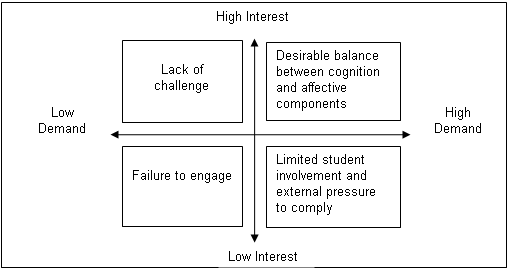
Figure 1. Representation of the relationship between cognitive demand and affective interest (Baird, Gunstone, Penna, Fensham, and White, 1990)
The authors propose that there are different levels of challenge that result from the interaction between interest and demand. These findings suggest that there is a relationship between affect, which we call aesthetics/appeal, and cognitive demand in traditional classrooms. Would the same relationship hold for web-based distance learning (WBDL) environments? Will difficulty of module content have any impact or interaction with the appearance variables? What would happen to the rating of appearance of a module if it is perceived as difficult? In our study perception of module content difficulty is measured to investigate its relationship with appearance characteristics.
Multimedia Learning
Multimedia is one of the most common terms used when referring to educational technology and distance learning. As defined by Mayer (2001), multimedia is the presentation of material using both words and pictures. Words in verbal form such as using printed or spoken text, and pictures when the material is presented in pictorial form such as using static graphics, including illustrations, graphs, photos or maps or using dynamic graphics, including animation or video. According to this definition WBDL modules, which contain a combination of audio, video, Power Point slides of text and pictures would be considered multimedia.
The Cognitive theory of Multimedia Learning, developed by Mayer (2001), rests on three basic assumptions about the human information processing system:
Humans possess separate channels for processing visual and auditory information (Paivio, 1986; Baddeley, 1992)
Humans are limited in the amount of information that they can process in each channel at one time ( Baddeley, 1992; Chandler & Sweller, 1991)
Humans engage in active learning by attending to relevant incoming information, organizing selected information into coherent mental representations and integrating mental representations with other knowledge. ( Mayer, 1999; Wittrock, 1989)
In the multimedia learning model (Figure 2) the arrows represent the steps of processing involved in the cognitive theory of multimedia learning: (1)selecting relevant words, (2)selecting relevant images, (3)organizing selected words, (4)organizing selected images, and (5)integrating verbal and visual representation as well as prior knowledge.
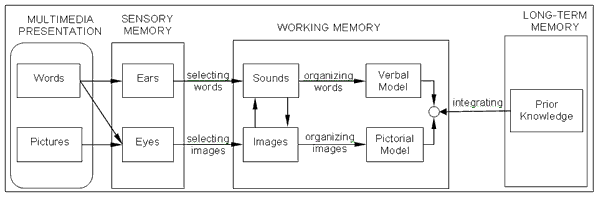
Figure 2. Visual representation of the Cognitive Theory of Multimedia Learning (Mayer, 2001)
This model predicts that when pictures (e.g., animation), spoken words (e.g., narration) and written words (e.g., text) are simultaneously presented in multimedia presentations, the visual channel will become overloaded. According to Mayer, this can happen in two ways, first, pictures and written words compete for limited cognitive resources in the visual channel because both enter the information processing through the eyes. Second, when verbal information is presented both visually and auditorily, learners may be tempted to attend to both in an attempt to reconcile the two information streams; this according to Mayer, requires cognitive resources that consequently are not available for processing the animation and mentally linking it with the narration. Mayer states that this theory predicts a redundancy effect in which adding on-screen text to a concise narrated animation will result in poorer learning as indicated by results of retention tests and in poorer understanding, as indicated by the results of transfer tests. Mayer uses the term redundancy to refer to any multimedia situation in which learning from animation (or illustrations) is superior to learning from the same materials long with printed text that matches the narration. What would happen when only spoken words and written words are used simultaneously, as in narrated text? Would the redundancy principle apply to a WBDL material which contains a video with audio of a professor teaching a class, and power point presentation of the material the professor is discussing? The material presented in power point includes pictures, graphs and/or text. The class segments used in the experiment as test material consist of different topics, but they are considered to be similar because they have the same professor, classroom and presentation style.
The Present Research
Many of the reviewed articles on distance education only focus on which type of format is best, comparing distance education to traditional face-to-face instruction (Allen et al., 2002; Ryan, 1976; Machtmes and Asher, 2000; and Rutz, et al., 2003). It is important to understand whether differences exist in student satisfaction between the instructional methods, but ultimately the interest relies not only on satisfaction and acceptance but on the impacts of the different technologies. We need to understand what affects student satisfaction directly and whether the design characteristics of distance learning environments are related to students’ judgments and performance.
We recognize the importance of environmental variables in WBDL modules as well as the value of evaluating the impact of aesthetic and affective dimension in the design and development of these environments. From the literature review (Boshier, et al., 1997) we see a need for a study that integrates the impact of WBDL characteristics on aesthetic preference variables and learning. Our first step in this study was to take the learner-centered approach (Mayer, 2001) to understand which WBDL environment characteristics may impact information recall and appearance judgments. On the basis of this work we further evaluated the impact of video on WBDL aesthetic judgments, (measured as perceived attractiveness, preference, and excitement), information recall (measured as number of phrases and keywords recalled), and perceived content difficulty with a sample of college of engineering undergraduate students.
In this paper we describe an experiment in which the following questions were addressed:
What is the relationship between the use of video in WBDL modules and retention of material as measured by phrase and keyword recall?
Which is the impact of instructor video on appearance judgments as measured by perceived attractiveness, preference and excitement?
What is the relationship between perceived difficulty, module type, information recall, and appearance judgments?
There are two main hypotheses behind this work: (1) The learning preference hypothesis suggests that as more media channels are included satisfaction will increase. According to this we hypothesized that there would be a difference in aesthetic appeal (module preference, excitement and attractiveness) for web modules presented with or without video. (2) Retention of information, measured by recall of phrases and keywords, in modules without video should be better than recall in modules with video, according to the cognitive theory of multimedia learning and the redundancy principle unless the video does not overload the visual channel.
Methods
An experiment was designed and conducted to evaluate the effects of web-module video on information recall, perception of content difficulty, and perceived appearance/aesthetic ratings. Six web-modules were used, consisting of 3 to 6 minute fragments of different lectures, each containing a different topic. Information recall was measured by the number of correct phrases that the participants were able to recall during a 2 minute interval immediately after the web-module presentation, and the total number of keywords that the participants used to compose the phrases. The phrases were checked against a transcription of the different modules. Aesthetic response was measured by the participants’ ratings of perceived preference, attractiveness and excitement of each web-module.
Participants
Sixteen undergraduate students between the ages of 18-21 years (8 females and 8 males), enrolled at the University of Michigan, College of Engineering, Ann Arbor, participated voluntarily in this experiment. All the participants were paid $15.00 each for their participation, completion of the experiment and following instructions.
Equipment and Materials
The experiment was conducted in the Usability Laboratory at the Duderstadt Center at the University of Michigan, Ann Arbor (see Figure 3 for the lab room setup). Two IBM computers were used in this experiment. Both computers had installed VNC viewer remote access software version 4.0 and Real Player version 10. The participant station consisted of an IBM Computer running Windows XP with a screen resolution of 1024x768pixels, speakers, mouse and keyboard. The mouse and keyboard were not used by the participants during the experiment but were provided to make the environment more realistic. The participants used the speakers to adjust the volume intensity of the different sounds played by the computer for each web-module. The experimenter station had an IBM computer running in Windows 98. The experimenter used the VNC program to connect to the participant’s computer, set up, and play the different web-modules that were evaluated during the experiment.
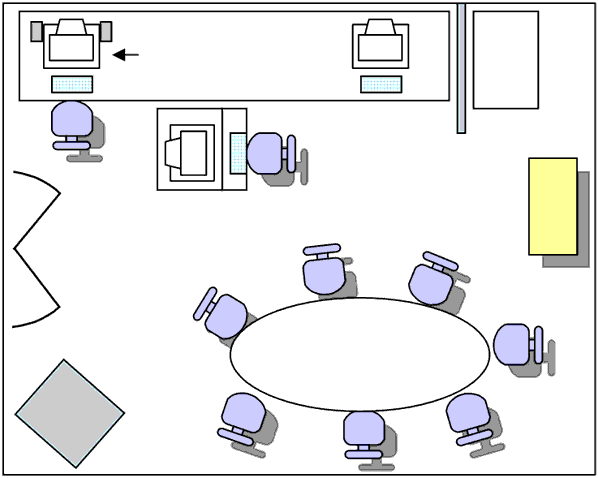
Figure 3. Configuration of the Usability Laboratory used for the experiment.
Web-Modules
Fragments of six lectures on Environmental Impact Assessment were selected on the following topics: Ground Water Contamination (4:38 min); Air Pollution Meteorology (6:34 min); Model Evaluation (6:17 min); Basis of Diffusion (6:16 min); Water Cycle (6:39 min); and Mixing Heights (3:14 min). This set of modules were presented to the participants with or without the instructor video using an Internet Explorer browser. Both types of modules included the instructor audio, audio/play controls and table of contents, the school heading, course slides, and copyright information, as shown in Figures 4. The table of contents within the web-module contained the course number and title, instructor name, module topic and a list of the slides contained in the module.
|
|
(a) (b)
Figure 4. Examples of web modules with video (a) or without video (b).
Procedure
The participants were greeted and escorted to the Usability Laboratory at the University of Michigan, Duderstadt Center. Once in the laboratory the participants were asked to sit in the chair provided in the assigned computer station, read and sign a consent form if they agreed to it. The experimenter then proceeded to load and play the first module on the participant’s computer with the VNC viewer program operated from the experimenter station. The participant was given the opportunity to adjust the volume of the computer speakers at any time and was not allowed to take notes. Once the module finished playing and stopped, the experimenter closed the module window on the participant’s computer screen. The participant was then handed a sheet of paper and asked to “write in two minutes as much as you can about what you heard or learned from the web-module you just saw”. After the two minute period, the participant was asked to wrap-up the writing and hand back the sheet. The participant was then given a second sheet with questions on general content and appearance. The participant was asked to mark his/her response with an X on a visual analog scale ranged between 0-10. In the content question the participant was asked the following:
1. Please rate with an X, the level of difficulty that this web-module presented, 0 being least difficult (simple) and 10 being most difficult.
Three additional questions on general appearance used the same visual analog scale. The participant was instructed to answer these questions without considering the content of the web-module. The general appearance questions read as follows:
Please rate with an X, your preference for the web-module you just viewed, 0 being least preferred and 10 being most preferred.
Please rate with an X, how attractive is this web-module you just viewed, 0 being the most displeasing or unattractive and 10 being the most pleasing or attractive.
Please rate with an X, how exciting is this web-module you just viewed, 0 being the most sleep producing/boring and 10 being the most exciting.
Once the participant finished answering the content and appearance questions the experimenter loaded the next web-module to be played on the participant station, by clicking on a menu and maximizing the corresponding window to full screen. This procedure was repeated for each of the modules presented for a total of 6 trials. For analysis purposes, the first two modules were considered practice trials and the participants were informed the first two trials were practice and how many modules they were going to see. A 4*4 Latin-Square matrix was used to randomize and counterbalance the trials. Details for the Latin-Square matrix are shown in Tables 1 and 2.
Table 1
The 4*4 Latin Square Matrix for participants 1-4
and counterbalanced order for participants 5-8 with practice trials.
Participant Number | Gender | Trials | |||||
Practice | Experimental | ||||||
1 | 2 | 3 | 4 | 5 | 6 | ||
1,9 | M | E | F’ | A | B’ | C’ | D |
2,10 | M | E | F’ | B’ | C’ | D | A |
3,11 | F | E | F’ | C’ | D | A | B’ |
4,12 | F | E | F’ | D | A | B’ | C’ |
5,13 | M | F’ | E | D’ | C | B | A’ |
6,14 | M | F’ | E | A’ | D’ | C | B |
7,15 | F | F’ | E | B | A’ | D’ | C |
8,16 | F | F’ | E | C | B | A’ | D’ |
Table 2
Assignment of web-modules to Latin-Square variables
and coding used to identify the variables.
| Lesson | Module Type |
A | Model evaluation | video |
A’ | audio | |
B | Basis of diffusion | video |
B’ | audio | |
C | Water Cycle | video |
C’ | audio | |
D | Mixing Heights-Atmosphere | video |
D’ | audio | |
E | Ground Water contamination | video |
F’ | Air pollution meteorology | audio |
|
|
|
Data Analysis
Six dependent variables were measured, including three content variables and three appearance variables. The content variables were: information recall and perceived difficulty of the web-module material.
Information recall was measured in two ways: (1) the number of correct phrases or sentences that the participants were able to write during the two minute interval after the web-module presentation; and (2) the total number of keywords that the participants used to compose the recalled phrases. The keywords were selected by identifying those words (nouns or verbs) in the participants’ written text which was explicitly stated by the instructor—through the audio or video, and slides—and appeared on a transcription of the web-module. Perceived appearance or aesthetic response was measured by the ratings of perceived preference, attractiveness and excitement that the web-module appearance produced in the participants without considering the content of the web-module material. Figure 5 shows the hypothesized relationships between the dependent variables. The data analysis evaluated the effect of video on the dependent variables using within-subject ANOVA, the analysis did not consider the participant responses for the practice trials (trial 1 and 2). A factor analysis was conducted to verify the hypothesized relationships between the dependent variables. SPSS version 11 software was used as the data analysis tool.

Figure 5. Hypothesized relationships between dependent variables measured in this experiment.
Results
Research Question (1) What is the relationship between the use of video in WBDL modules and retention of material as measured by phrase and keyword recall?
The ANOVA results show a significant difference in the number of phrases recalled by the participants for modules with or without video, as shown in Table 3. This finding is important because it suggest that having the video of the instructor in a multimedia presentation of WBDL material does have a significant effect on the amount of information that is retained by the participants. On average participants recalled about one more phrase when the modules were without video as opposed to modules with video (μ=5.5, σ=1.4 and μ =4.8, σ=1.5 respectively). On the other hand, there was no significant difference between the presence of video and the amount of keywords that participants used to compose the phases to explain what they remembered from the WBDL modules (p>0.30).
Table 3
Means & ANOVA results for information recall variables and module type.
Information Recall Variables | ANOVA | Video | Audio | ||||||
Sum of Squares | df | Mean Square | F | p-value | Mean | SD | Mean | SD | |
Phrase | |||||||||
9.000 | 1 | 9.000 | 4.429 | .039 | 4.75 | 1.46 | 5.50 | 1.39 | |
Keywords | |||||||||
15.016 | 1 | 15.016 | .950 | .334 | 10.34 | 3.84 | 11.31 | 4.11 | |
Research Question (2) Which is the impact of instructor video on appearance judgments as measured by perceived attractiveness, preference and excitement?
The answer to the question is that there is an impact and a significant difference between the three appearance/aesthetic ratings and the module type (with or without video), as shown in the analysis of variance. Table 4 shows the results for the analysis of variance and the correlations between use of video in WBDL modules and appearance ratings.
Table 4
Results of analysis of variance and correlation results
for appearance ratings variables and module type
Appearance/ Aesthetic Ratings | ANOVA | Non Parametric Correlations | |||||
Sum of Squares | df | Mean Square | F | p-value | r | p-value | |
Preference | |||||||
66.016 | 1 | 66.016 | 14.407 | .000 | -.422 | .001 | |
Attractiveness | |||||||
43.891 | 1 | 43.891 | 9.175 | .004 | -.345 | .005 | |
Excitement | |||||||
43.891 | 1 | 43.891 | 9.156 | .004 | -.351 | .004 | |
Figure 6 shows the overall mean response of participant perceived preference, attractiveness and excitement of the WBDL modules by module type. The mean response shows that there is an inverse relationship between information recall and appearance ratings. As mentioned earlier, participants recalled a larger number of phrases for modules with no video (only audio) when compared to modules with video. On the other hand, appearance ratings were higher for modules with video, when compared to modules without video.
These significant differences between the appearance ratings for modules with or without video provide support for the learning-preferences hypothesis. This hypothesis states that different people learn in different ways, so it is best to present information in many different formats and as less information is presented, the level of satisfaction of the user would decrease. In this study satisfaction was not directly measured but the results might suggest that appearance variables are related to satisfaction.
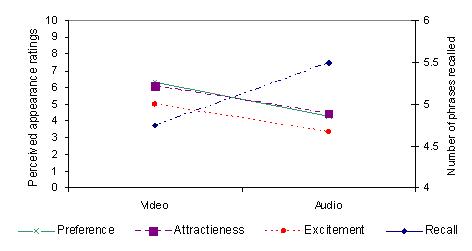
Figure 6. Mean ratings of appearance judgments and number of phrases recalled for modules with and without video.
Research Question (3) What is the relationship between perceived difficulty, module type, information recall, and appearance judgments?
The difficulty variable was not related to the use of video in the WBDL modules, but it was related to the other dependent variables. There was a significant negative correlation between perceived content difficulty, excitement and attractiveness ratings (r = -0.309, p<0.05, and r = -0.270, p<0.05 respectively), suggesting an inverse relationship between these two variables. The difficulty variable was also significantly correlated with the phrase and keyword recall variables (both with a correlation of r = -0.298, p<0.05).
Figure 7 shows the overall mean ratings of perceived attractiveness, phrase recall and content difficulty for each of the web-modules by type and topic. First, the graph suggests that there is an inverse relationship between content difficulty and attractiveness/aesthetic ratings for most of the modules except for the module on atmosphere and mixing heights. As ratings of content difficulty increase the ratings of perceived module attractiveness seem to decrease but when content difficulty decreases (the content is perceived as simple) the web module appearance is perceived as more attractive (the same trend occurred for perceived excitement).
There is another important relationship shown in Figure 8 with respect to content variables (difficulty and information recall). As mentioned earlier, modules with audio only (no video) have higher information recall but they also are perceived to be more difficult. This seems to suggest that content and appearance/aesthetic variables are related and not independent.
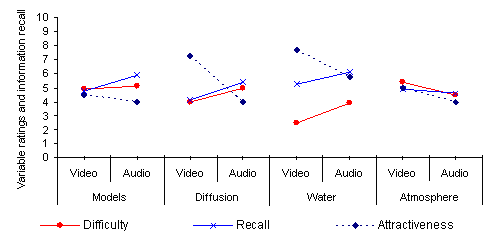
Figure 7. Overall mean of perceived attractiveness ratings, information recall and content difficulty for the web-modules by module type and topic
Factor Analysis of dependent variables
This study evaluated the effects of design characteristics on six dependent variables and assumed that all the dependent variables were represented by two main factors. A further analysis of these variables using principal component analysis confirmed that there are indeed two main factors that relate the variables. A factor analysis with varimax rotation was used and the two components shown correspond to the two previously identified major dependent variable groups of content and appearance, as shown in Table 5:
Table 5
Factor analysis results for the dependent measures
| % Variance | Original Matrix | Rotated Matrix Method: Varimax with Kaiser Normalization | ||
Component | Component | ||||
1 | 2 | 1 | 2 | ||
Phrase Recall | 47.6 | .288 | .837 | -.124 | .877 |
Keyword Recall | 24.1 | .559 | .613 | .219 | .800 |
Difficulty | 11.8 | -.575 | -.304 | -.374 | -.532 |
Preference | 7.4 | .835 | -.358 | .906 | 6.075E-02 |
Attractiveness | 5.1 | .842 | -.314 | .893 | .103 |
Exciting | 3.8 | .851 | -.229 | .863 | .182 |
Discussion
The learning preference hypothesis suggests that as more media channels are included satisfaction will increase. Accordingly, we hypothesized a difference in aesthetic appeal (module preference, excitement and attractiveness) for web modules presented with or without video. The results of this study provided support to our hypothesis. In this study satisfaction was not measured as one of the dependent variables, but preference ratings for appearance judgments. The results suggest that one of the aspects of satisfaction might be related to appearance/aesthetic appeal. Along the same line, the Cognitive Theory of Multimedia Learning, developed by Mayer (2001), predicts that when pictures (e.g., animation), spoken words (e.g., narration) and written words (e.g., text) are simultaneously presented in multimedia presentations, the visual channel will become overloaded. Following this theory, we expected to find a higher recall of phrases and keywords in modules without video than in modules with video. We considered the visual stimulus provided by the video and the slides, in addition to the auditory stimulus of the audio, could possibly overload the participant’s visual channel. The results of this study showed a significant relationship between information recall variables and the independent variable, with a higher recall on modules without video than those with video. One possible explanation for these findings is that having video present for multimedia presentations would overload the visual channel, therefore contributing to lower amounts of information remembered. As stated earlier, the Cognitive Theory of Multimedia Learning defines spoken word as narration of present text and pictures as animations in the multimedia presentation, but does not address situations in which a multimedia presentation is defined as a video recording of a lecturer.
With respect to the dependent measures, content difficulty and appearance were found to be significantly correlated. These findings support Baird, et al. (1990) results, which suggested that there is a relationship between affect and cognitive demand. The relationship between difficulty, appearance and information recall is important and a balance should be attained.
The results of this study show that appearance does matter in web-based distance learning technology. This finding is valuable because it clearly shows that studying users’ appearance/aesthetic judgments provides important insights to designers and practitioners on which specific variables within the WBDL environment make an impact in learner’s perceptions and performance.
The trends in the data between use of video and retention variables, opens an avenue for future research and understanding the participants’ tolerances and preferences to different instructor video formats. The impacts of video size, quality, and location within the WBDL module on appearance judgments and learning are possible extensions of this work. Our study and future research in this area would provide scientific evidence to support WBDL environment design decisions integrating the aesthetics perspective.
References
Allen, M., Bourhis, J., Burrell, N., & Mabry, E. (2002). Comparing Student Satisfaction with Distance Education to Traditional Classrooms in Higher Education: A Meta-Analysis. The American Journal of Distance Education, (16)2, 83–97
Baddeley, A.D. (1992). Working memory. Science, 255, 556-559.
Baird, J.R., Gunstone, R.F., Penna, C., Fensham, P.J., & White, R.T. (1990). Researching balance between cognition and affect in science teaching and learning. Research in Science Education, 20, 11-20.
Bork, A. (2000). Four fictional views of the future of learning. Internet and Higher Education, 3, 271-284.
Boshier, R., Mohapi, M., Moulton, G., Qayyum, A., Sadownik, L., & Wilson, M. (1997). Best and Worst Dressed Web Courses: Strutting Into the 21st Century in Comfort and Style. Distance Learning Education: An International Journal, 18(2).
Chandler, P., & Sweller, J. (1991). The split-attention effect as a factor in the design of instruction. British Journal of Educational Psychology, 62, 233-246.
Heinich, R., Molenda, M., & Russel, J.D. (1982). Instructional Media and the New Technologies of Instruction. John Wiley and Sons.
Keegan, D.J. (1996). Foundations of Distance Education, 3rd edition. London: Routledge.
Keegan, D.J. (1988). Problems in defining the field of distance education. American Journal of Distance Education, 2(2), 4-11.
Liu, Y. (2003a). Engineering Aesthetics and Aesthetic Ergonomics: Theoretical Foundations and a Dual-Process Methodology. Ergonomics, 46(13/14), 1273-1292.
Liu, Y. (2003b). The Aesthetic and the Ethic Dimensions of Human Factors and Design. Ergonomics, 46(13/14), 1293-1305.
Machtmes, K., & Asher, J. (2000). A meta-analysis of the effectiveness of telecourses in distance education. The American Journal of Distance Education, 14(1), 27–46.
Mayer, R. (2001). Multimedia Learning. New York, NY: Cambridge University Press.
Mayer, R. (1999). The promise of educational psychology. Upper Saddle River, NJ: Prentice Hall/Merrill.
Miller, S.M., & Miller, K.L. (2000). Theoretical and Practical Considerations in the Design of Web-Based Instruction. In B. Abbey (Ed.), Instructional and cognitive impacts of Web-based education. Hershey, PA: Idea Group Publishing.
Paivio, A. (1986). Mental representations: A dual coding approach. Oxford, England: Oxford University Press.
Rutz, E., Eckart, R., Wade, J.E., Maltbie, C., Rafter, C. & Elkins, V. (2003). Student performance and acceptance of instructional technology: Comparing technology-enhanced and traditional instruction for a course in Statistics. Journal of Engineering Education, 133-139.
Ryan, M.G. (1976). The influence of teleconferencing medium and status on participants’ perception of the aestheticism, evaluation, privacy, potency, and activity of the medium. Human Communication Research, (2), 255–261.
Svetcov, D. (2000). The virtual classroom vs. the real one. Forbes, 166, 50-54.
Wittrock, M.C. (1989). Generative processes of comprehension. Educational Psychologist, 24, 345-376.
Acknowledgments
We thank Vic Divecha for his assistance in selecting and preparing the WBLD modules used in this study, and Virginia Soto and Aditya Sthanunathan for their assistance in conducting the experiment.
About the Authors
Cristina Pomales-Garcia, MS. is a graduate student and Ph.D. Candidate in the Department of Industrial and Operations Engineering at the University of Michigan. Address: 1205 Beal Ave. Ann Arbor, MI 48109-2117 USA; tel: 734-764-6473, fax: 734-764-3451, e-mail: cpomlaes@umich.edu | |
Yili Liu, PhD. is Arthur F. Thurnau Professor and Associate Professor of Industrial and Operations Engineering at the University of Michigan. Email: yililiu@umich.edu |
